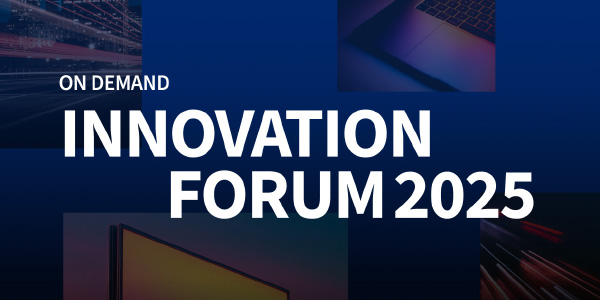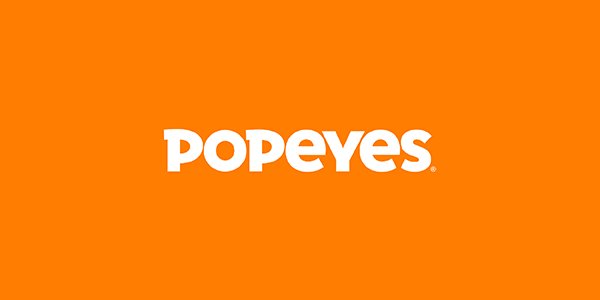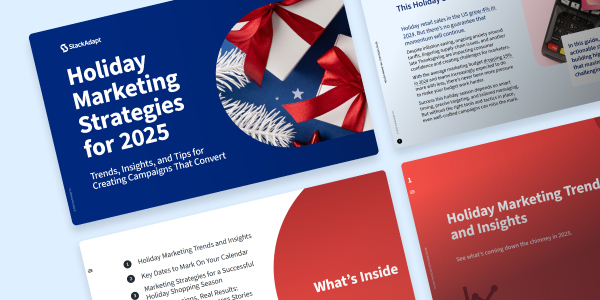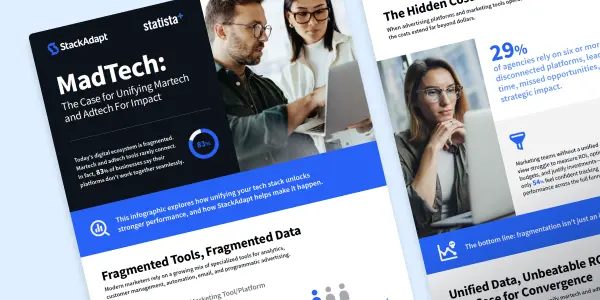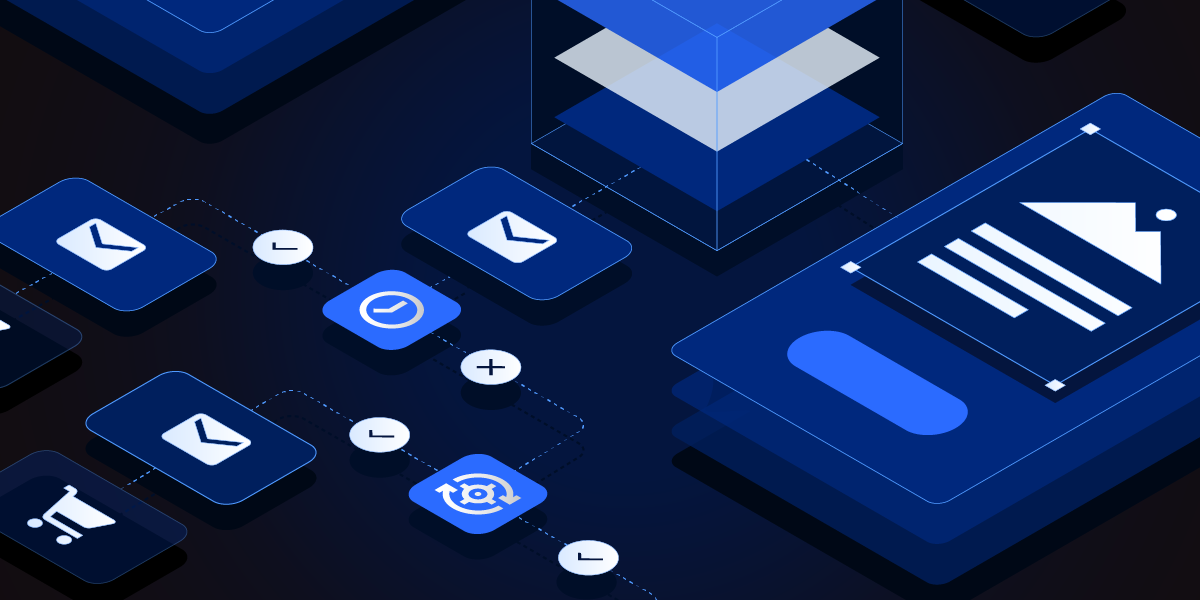The AI Advertising Podcast: S1
Episode 9
AI Tools for Marketers: The New Martech Stack

About This Episode
The martech landscape is changing fast—and AI is at the center of it. But with so many new tools launching every week, how do marketers know what’s worth their time? In this episode, we unpack the AI tools that are making a real impact for creative teams, media buyers, and marketing strategists—and where the tech is heading next.
Scott Brinker | VP of Platform Ecosystem, HubSpot
Amélie Moritz | Technical Product Manager, StackAdapt
Transcript
Diego Pineda (00:00:00)
What’s the top tool marketers are using right now? That question used to spark long debates—nowadays, the answer is almost always the same: AI. But AI tools aren’t just another shiny object in the MarTech stack. They’re reshaping how marketers think, create, and execute—sometimes radically.
In this episode, we’re cutting through the noise to explore which AI tools marketers are using today; which tools are changing the game for advertisers and creative teams; and what’s next—beyond the hype?
We’ll hear from Scott Brinker. He is the VP of Platform Ecosystem at HubSpot. Also from Amélie Moritz, Technical Product Manager at StackAdapt. And some regulars from this show, Te’Shawn Dewyr and James Targett, from StackAdapt’s Creative Studio. Let’s get into it.
Podcast Intro (00:00:49)
Welcome to the AI Advertising Podcast, brought to you by StackAdapt. I’m your host, Diego Pineda. Get ready to dive into AI, Ads, and Aha moments.
Diego Pineda (00:01:02)
To kick things off, let’s take a step back. AI has shifted beyond niche curiosity to a mainstream must-have. But what’s actually changed for marketers on the ground? Scott Brinker from HubSpot has been tracking the growth of the marketing tech landscape for years, and what he’s seeing right now is… different.
Scott Brinker (00:01:24)
Yeah, I think it is a pretty massive wave of innovation. I mean, it’s interesting because there’s certainly dimensions of AI that have been steadily growing inside the martech stack for more than a decade, you know. Traditional machine learning, like helping us understand cohorts and segments and churn propensity and you know all these wonderful capabilities that we’ve been leveraging through traditional machine learning.
But this sort of next wave of AI, the generative AI, LLM engines, definitely were the catalyst for… It is pretty remarkable because it’s changing so many different dimensions of what we can do with martech. This ability to have these new user interfaces that allow us to interact with software, whether we’re, you know, like a marketer or an end customer, using natural language as a way to interact with these systems is unlocking so much power. I think generative AI and being able to dramatically accelerate production, particularly content production. But also now you know we’re seeing this emergence of true AI agents, this ability to, you know, have these new kinds of software you know that are leveraging AI intelligence to be able to operate more autonomously, to be able to make more decisions. And this isn’t like replacing the existing martech stack. In many cases here, this is augmenting the existing martech stack, but it’s dramatically accelerating the sophistication of what’s even going to be possible and how we run our marketing organizations and what sort of interfaces and touch points we present to customers. So I would say it is the most exciting time I have ever had in the history of martech.
Diego Pineda (00:03:09)
Scott’s right. One of the most transformative shifts is how AI allows marketers to interact with data and tools in plain English—you no longer have to be a data analyst to get answers from your data.
Scott Brinker (00:03:23)
We’re starting to see like people leverage these generative AI tools to be able to democratize more analytics and data exploration. So I don’t have to be a data analyst to be able to ask a question in natural language and have the AI help look at my data and help me find that answer. I mean, marketers, I mean, this is one of the superpowers of marketers, in my opinion, is they always have these like, you know, great questions, you know, that they want to get the answers to as insights to drive their strategy and their campaigns. But there’s often been a pretty significant delay between, oh, I have this question, what’s going to be involved in actually getting it answered? And to me, one of the most powerful things we’re seeing right now is this wave of AI technology shortening the distance from someone as a marketer, not a data scientist, but as a marketer having a question and being able to get an answer to it.
Diego Pineda (00:04:16)
While AI tools are transforming back-end workflows, they’re also showing up in the most hands-on part of marketing: the creative process. To understand how, I spoke with Te’Shawn Dewyr and James Targett from StackAdapt’s Creative Studio. These folks are building, testing, and adapting ad creatives every day—and they’re seeing real benefits from integrating AI into their work.
Te’Shawn Dewyr (00:04:39)
Tools like the Adobe CC Suite where they’ve just started to implement all these AI tools in it. It’s interesting because these are tools that designers, motion designers, our graphic artists already use. So now they’ve got a whole field of AI capabilities to use along their existing work, right? So I may be working with an ad that My image is a little too small. Now in Photoshop, I can jump in there, generate that background to cover that whole new canvas I have. Now, I don’t need to ask the client for a new image. I don’t need to source any stock photo. I’m good to go, right? So I think a lot of the traditional tools we have that are implementing those AI tools are definitely going to make big waves in the future.
James Targett (00:05:26)
Yeah, T’s definitely, definitely right about that. Actually, when I use these tools recently, they really surprised me at how good they were. And they’re just built into things that designers and marketers are using every day. In addition to those, I would actually say that the one, I guess, like one of the original ones, most people have heard of this is Midjourney, like Midjourney was a really impressive um image generator. I would say it was probably the leader. It might still be, I haven’t been checking up on them recently.
And the interesting thing about Midjourney to me is that it has a default preference toward really pretty images, like really strong compositions, really beautiful things. So I think maybe that’s part of why people were drawn to it so early. But the challenge with a tool like Midjourney is, and again, I don’t know if they’ve changed this recently. But to generate images through them is you would actually have to go through Discord. So you would be in a Discord channel and sort of like run your request through there. So when you look at leveraging this as a marketer or an agency or even a team such as ours, it’s like, how do I set that up in a production pipeline? Like there’s a couple extra additional steps that kind of make ah the underlying technology a little bit inaccessible.
Diego Pineda (00:06:43)
The takeaway here? AI tools are getting better at saving time and scaling design work—but they still need to be seamless to be useful. The more they integrate into tools marketers already use, the bigger their impact will be.
Diego Pineda (00:07:02)
Now let’s look at something that’s flying under the radar: AI as a true assistant—not just as a content or image generator, but a tool that helps you interact with your own data. At StackAdapt, this has taken shape as Ivy—an AI-powered assistant that helps marketers manage and optimize campaigns without endless clicking and spreadsheet wrangling. Here’s Amélie Moritz, Technical Product Manager at StackAdapt, on what makes Ivy different.
Amélie Moritz (00:07:27)
Ivy is our AI-powered assistant. So, today Ivy can help with obviously answering general questions, right? So if you’re wondering, you know, oh, how do I launch a campaign on StackAdapt? Oh, hey, I’m interested in this HubSpot integration. How does it work? Or what are the capabilities? Ivy can do that. But I think if you’re looking broader than just a chatbot, we’re also providing additional value by allowing you to talk to your data. So that’s how we call the feature internally. It’s called talk to your data, but it’s basically having the ability to ask Ivy about your own campaign data instead of having to browse through your reports. So let’s say you launch a campaign and it could actually be a live campaign, something that’s still running. And you’re obviously wondering, hey, is everything pacing? Is everything all right? Or what’s my eCPM or what’s my CTR? Is this on par with what I’m expecting? Today, you probably have to go through our reporting tab and you have to find the right report and then you have to find the right metric, make sure it’s for the right campaign.
But with Ivy, you can ask this directly in your natural language. So you can ask, hey, what’s the CTR of my life campaign? Or show me what’s my top-performing campaign with regards to CTR, for example. The third one would be, again, bouncing off ideas. So being like, hey, I’m willing, I want to run an awareness campaign and my goal is to target the top of the funnel and I’m thinking of running a programmatic campaign on native. Is this a good idea? And my industry is e-commerce. Ivy can provide recommendations and say, hey, actually, you know what? Perhaps consider this channel or perhaps make sure that you include this in your strategy. Or… even more technical stuff. And this would probably be for perhaps more, I guess, both more experienced users, but also people who are new to the platform. And you can ask, hey, I have to set up this pixel. What are the steps? How can I configure this? Oh, hey, I have this macro. Can you make sure that this is actually correct before I go implement it? So again, going back to that assistant idea where you know you know that you have this kind of yeah, side person who can always, you know, help you if you have a question or if you need to kind of double-check something.
Diego Pineda (00:10:01)
That’s where AI shines—not in replacing marketers, but in helping them do the high-impact work faster and with fewer roadblocks.
Diego Pineda (00:10:14)
Alright, we’ve seen what’s working today. But what about tomorrow? What will AI tools look like as they evolve in the next few years? Will we all become prompt engineers? Or will AI get smarter about understanding what we want—without us needing to spell it out? Amélie and Scott both had interesting takes on where AI tools are heading.
Amélie Moritz (00:10:36)
With the current Gen AI tools, it’s a lot about how you prompt that Gen AI tool, you know, and how you craft your prompts. So make sure that you provide enough context, make sure you’re specific enough, or make sure you frame it in a certain way to get a certain output. But I don’t think people, especially marketers, I don’t think they want to be trained or have to learn something new to be able to use those tools. I think they want to be able to think in terms of outcomes. Here’s what I want to achieve. And behind the scenes, instead of perhaps having just, and I don’t want to say a simple model, but just having a generic model, you’re going to have agents. And so, Gen AI is going to be able to think on its own if you want. And okay, here’s the outcome. And here are the different building blocks or blocks I can leverage. Which one should I leverage to reach this outcome? And this puts the complexity not on the users, but rather behind the scenes. And I think that’s probably what’s going to be the strength of the future product that include AI, because it’s no longer going to be just about branding a feature or product as AI powered is going to be about the ease of use and whether it’s actually solving the right problems.
Scott Brinker (00:11:52)
Again, one of the reasons this is the most… just fascinating time I’ve ever seen, not just, you know, in the history of martech, but, you know, in the history of technology that I’ve come across is it’s changing and evolving so rapidly that I’m, I don’t think I’m in a position to even like predict accurately, like, oh, well, what will this be in five years? I honestly don’t know. But I do know that there are steps we can take that get us in the right direction, you know. And again, this is like designing both our tech stack and our organizational operations to embrace change, embrace adaptability, embrace agility. I think we know that our data infrastructure, our data foundations are key to really being able to effectively leverage AI. The data was always like, you know, crucial to us before this whole AI wave. But I think with AI, it’s you know maybe like a 10x, the value of really getting our data infrastructure and our data you know processes strongly in place. And then, yeah, the third thing is you know, hands-on and experimenting and learning and trying to figure out, oh, what what can I do with this? You know, so I think if you’re like leaning into that agility, adaptability, if you’re leaning into good data investments, if you’re leaning into empowering people to experiment and learn, I’m not sure exactly what the future is going to be five years from now, but that feels like the path to get there.
Diego Pineda (00:13:22)
And there’s a big future ahead for personalization at scale, too.
Te’Shawn Dweyr (00:13:26)
When these tools evolve and mature more with, you know, increased automation and customization, especially when we talk about like AI personalization, that is going to be huge for people and they’ll start seeing the effects of that, right? So when I can make, let’s say a single ad and select the markets that I’m running in. And then having that translate my headline for, let’s say, Texas versus New York, I think that will be huge. But also when AI has the capability to kind of tap into more of the data and insights. So if I wanted to reference things like a different competitor or a different product that’s similar, once I can start automatically putting that stuff with my prompt. I definitely think that is going to change the future.
Diego Pineda (00:14:12)
From creative production to campaign management to personalization—AI is not just a trend. It’s a transformation.
Diego Pineda (00:14:22)
So, what should marketers take away from all this? First, AI tools are already saving time in creative and campaign workflows. Second, the best tools are becoming invisible—they’re showing up inside the platforms we already use. And finally, what’s coming next is even more powerful: tools that understand your goals, personalize at scale, and make decisions based on real-time insights.
To learn more about using AI tools like Ivy in your advertising campaigns, head to stackadapt.com and book a demo. The marketers who lean into AI now won’t just work faster—they’ll think bigger.
Podcast Outro (00:15:03)
Thanks for listening to this episode of The AI Advertising Podcast. This podcast is produced by StackAdapt. Visit us at stackadpat.com for more information about using AI in your advertising campaigns. If you liked what you heard, remember to subscribe, and we’ll see you next time.
